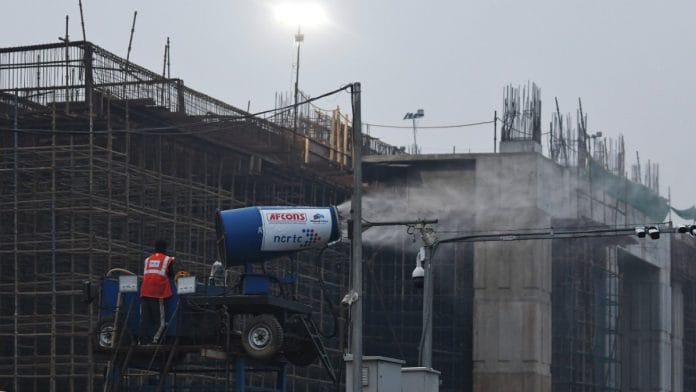New Delhi: The city of Amravati was among the top performers in the 2023 edition of the government’s Swachh Vayu Sarvekshan (Clean Air Survey), but ranks at the bottom in the National Clean Air Programme (NCAP) assessment of improved PM10 levels in cities.
This is an example of the kind of information mismatch highlighted by the Centre for Science and Environment’s new report titled ‘National Clean Air Programme: An Agenda for Reform’. Released on 19 July, this report assesses the performance of the flagship air pollution management strategy of the Government of India over the last five years.
The NCAP was launched in 2019 and applied to 131 non-attainment cities, including cities with a million-plus population, where air quality was regularly beyond the National Ambient Air Quality Standards (NAAQS).
The NACP is a performance-based funding scheme, which means that access to funding for cities is dependent on their performance and achievement of clean air targets.
The report by the Delhi-based think tank said over Rs 19,711 crore have been unlocked under this programme for 82 cities that are funded directly by the NCAP and 49 that are funded by the 15th Finance Commission air quality performance grant. CSE’s report focuses on three characteristics of the funding mechanism of NCAP – its performance-based nature, its various sources of funding, and the destination of the funds.
One concerning issue the report points out in the performance assessment of NCAP cities is that it largely focuses on reducing PM10 levels, despite PM2.5 levels being proven to be more harmful.
Given that the assessment focuses on PM10 levels, the report finds that most of the air pollution mitigation strategies and funds too focus on reducing it, through dust control on roads. According to it, 64 percent of the total funds in NCAP have been used for road dust mitigation, while only 0.61 percent have been used for industrial pollution.
“While NCAP’s objectives and aims have always been commendable, we are finding that attention and investments under it are largely focused on dust control, and not on emission-spewing combustion sources such as industries or vehicles. A balanced approach to funding is critical for effective impact,” CSE director general Sunita Narain said in a press release.
Also Read: Air pollution linked with 33,000 deaths in India each year between 2008 & 2019, finds Lancet study
Data mismatches and need for central action
The CSE report takes a broad overview of clean air action strategies of the government which include the Swachh Vayu Survekshan (SVS), a 2022 initiative by the Ministry of Environment, Forests, and Climate Change that aims to rank all 131 NCAP cities based on their implementation of City Action Plans for clean air.
While NCAP ranks cities based on their air quality levels, SVS ranks them based on how well they have implemented the action plans drafted to improve their air quality.
However, CSE’s report finds major discrepancies between the two rankings, with many examples like that of Amravati. For example, Delhi scored a high rank under the SVS ranking in 2023, indicating that it did implement its air quality action plan strategies successfully, however, its NCAP score for the same year was 0 — meaning there was no change in its PM10 levels. Guntur, Rajahmundry, and Agra fared similarly.
Moreover, some cities including Bhopal, Srinagar, and Firozabad performed similarly on both rankings, indicating that there isn’t a clear pattern between the two ranking systems even though they’re assessing correlated factors.
Another important issue the report flagged was the need for a streamlined national-local approach to targeting sector-wise pollution levels. As the funding data shows, there’s a focus imbalance on certain sectors like dust vis-a-vis others like public transport emissions, biomass burning, and industrial emissions. One of the main reasons for this could also be the need for central intervention in policy-making regarding these sectors.
Clean fuel lists for public transport, for instance, need central support so that states and cities are able to implement it. So, while action needs to be local to manage air pollution, there is scope for more central policy-making.
Additionally, the problem of transboundary air pollution needs to be targeted at the federal level with the central government helping states cooperate to mitigate it.
Reform measures suggested
From the introduction of green municipal bonds to transparency in SVS ranking criteria, the report suggested a host of measures for the next phase of the NCAP. Since the funding from the 15th Finance Commission plan will come to an end by 2025, the report recommends other measures of raising funds for municipalities and urban bodies.
Green municipal bonds, similar to the existing municipal bonds system in the urban bodies of Indore and Visakhapatnam, is one such measure.
The report also calls for more transparency in the ranking criterias of both SVS and NCAP, so that the public and the authorities are aware of strategies which are working and which are not.
Given the discrepancies between both rankings, it is clear that local action does not always translate into air pollution reduction.
However, the way to figure out where to improve action and which strategies to push more is by comparing the sector-wise ranking criteria of both.
“The new agenda for clearing the air has to gear up for scale and speed of change for transformative reform. That is possible only if the method of tracking progress and compliance gets stronger,” said CSE executive director (research and advocacy) Anumita Roychowdhury in the press release.
(Edited by Amrtansh Arora)
Also Read: As India grapples with EU carbon tax, renewables could help cut heavy industries’ emissions quickly






